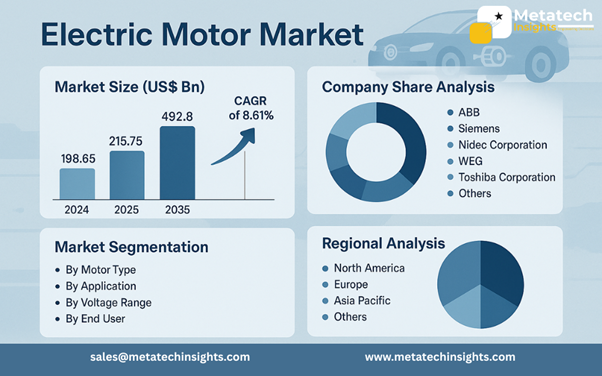Global Electric Motor Market to Hit USD 492.8 Billion by 2035 | CAGR 8.61%
09 Aug 2025 | Report ID: MI3348 | Industry: Novel Technology | Pages: 218 | Forecast Year: 2025-2035

Read more about this report- Global Electric Motor Market to Hit USD 492.8 Billion by 2035 | CAGR 8.61%
The Electric Motor Market is valued at USD 198.65 billion in 2024. The Electric Motor Market will achieve USD 492.8 billion by 2035 through a projected 8.61% CAGR from 2025 to 2035.
The main drivers of the electric motor market are the ongoing electrification revolution in the world and, in particular, the demand for energy-efficient systems and EV consumption. The main limitation has continued to be the cost of the new motor technologies and materials, e.g., rare earth magnets. Nonetheless, a new possibility consists of the harmonisation of AI and IoT-based motors in predictive maintenance and automation in smart factories and future automobiles.
The history market in terms of the type of motor can be divided into the AC motors, DC motors, and hermetic motors. The dominant motor of the AC motors is because of its energy efficiency, cost competitiveness, and large applications in industrial sectors, unlike DC motors, which are finding their way into electric vehicles and robots since they enable better control over the torque.
The market can be divided into the application segments of industrial machinery, HVAC, household appliances, automotive, and aerospace. The auto industry constitutes another area of growth due to the shift toward electric vehicles and regulatory effects of emission reduction, as well as innovative ideas of lightweight motor materials and batteries.
Industrial automation, HVAC, electric vehicles, drones, robotics. We use electric motors in industrial automation, HVAC systems, electric vehicles, drones, and robotics. Of these, electric automobiles are on a steep escalation pattern, and permanent magnet synchronous motors (PMSMs) are being incorporated to boost range and efficiency. More recently, there have also been solid-state motor controllers and silicon carbide semiconductors to make powertrains more efficient.
Strict energy efficiency standards and the developments in motor design, as well as research on smart grids and factory automation, are the major elements that influence the market. The German government has been facilitating the adoption of energy-efficient, electric motors in manufacturing factories with its “Energy Efficiency Strategy 2050” initiative and is rapidly ramping up domestic demand, in turn modernising ageing systems.
The geographical segmentation within the market is North America, Europe, Asia Pacific, Latin America, the Middle East, and Africa. Asia Pacific has the largest market share, as it holds a strong manufacturing base, car production, and emerging electrification in some of its countries, such as China and India. India is one influential contributor to growth because the production of motor vehicles and the use of electric vehicles are rising under the initiative of Make in India and the Faster Adoption and Manufacturing of Electric Vehicles (FAME).
Siemens AG, ABB Ltd, Nidec Corporation, WEG Industries, and Toshiba Corporation are the main market players of electric motors. The innovation in the high-efficiency motors, acquiring other regional players, and entering the digital motor systems that support Industry 4.0 standards enable these companies to define the growth of the market. They are also investing in sustainable motor technology and low-voltage motors in novel applications in e-mobility and decentralised energy.
Maximize your value and knowledge with our 5 Reports-in-1 Bundle - over 40% off!
Our analysts are ready to help you immediately.
